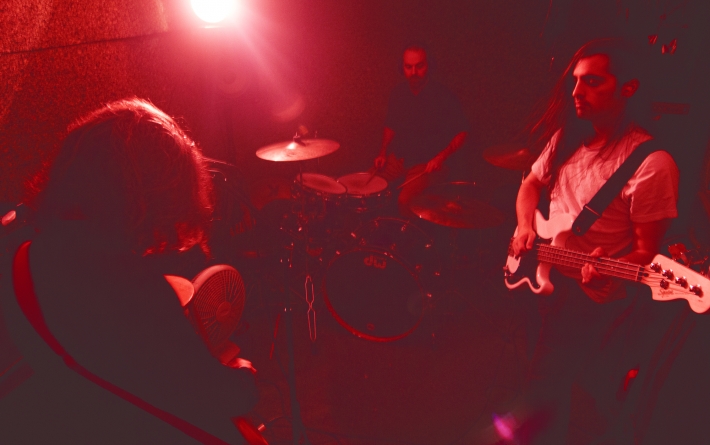
 Photo Courtesy: Colin McClutchy, Lindsay Hooker
Photo Courtesy: Colin McClutchy, Lindsay Hooker
Today’s popular music is dominated by sterile and artificial sounding instrumentation; while it does have a charm of its own, there is something very machine-like and rigid about it that sticks out like a sore thumb. Considering this type of thinking has dominated playlists and radio for a while now, it’s always nice when one finds music that is made in a more free and human way. New York-based band Minaxi uses this as a cornerstone of their output, and it’s extremely refreshing to hear what comes out of it.
The band’s latest singles ‘Ae Khuda’ and ‘Stargazer’ are great examples of how this works. The songs breathe and have a lilting feel to them that gives the listener so much more space and time. The production of the music itself is also organic, warm and sometimes noisy; the realness of all the elements really helps the layers of the instrumentation stand out while meshing into a cohesive whole at the same time. The band freely uses elements of synth, shoegaze and rock to come up with a sound that is old-school and nostalgic and yet sounds like something fresh that’s merely a few listens away from being the next big thing. In the below interview, the band’s co-founder, songwriter and vocalist talks about his journey and his musical identity.
Can you speak about your general musical journey and how that has led to Minaxi?
I grew up in a traditional, middle-class Indian family an hour north of Mumbai. Neither of my parents practiced music but they are both avid music listeners. I grew up listening to Hindustani pop music that was on the radio and television in the 90s. In my teens, I was heavily influenced by the pop, rock and sufi music of Pakistan. Jal (my favourite band back then, second only to The Smashing Pumpkins now), Strings, Junoon and many others frequented my Winamp playlists.
I had a Casio SA-21 (classic!) growing up. I would listen to my favourite songs and then play the melodies on the keyboard. My dad got me a super-cheap Hobmer acoustic guitar on my 17th birthday. After several failed attempts to play the instrument as I had envisioned in my head, I put it away. A year later, I picked it up again and I haven't looked back since. From 19 to 23, my social life was pretty much non-existent. In hindsight, this helped immensely because I was able to devote all the free time at my disposal to learning the instrument.
In 2015, I moved to Baltimore to pursue Graphic Design (MFA) at the Maryland Institute College of Art (MICA). It is where I first met Patrick Hunt, MICAs Graduate Lab Head. I would schedule sessions with Patrick for a few hours every week to get acquainted with the lab's sound studio and learn about production. This prompted me to write songs. I failed time and again for about 2 years, which I have come to realize is normal when you're finding your sound. However, in 2017, just as I was about to graduate, I wrote 3 songs that I realized were sonically different than what I had been writing previously. Upon moving to New York in 2017, I wrote incessantly. Since I now had some material, I thought I’d collaborate with musicians and see how the songs sounded in a ‘band’ setting. I responded to an old-school, handwritten ad posted by Andrew (our former drummer) on the bulletin board at a rehearsal space close to my house, who was looking to play with a songwriter/guitar player. We played together for two hours and formed Minaxi soon after.
We're essentially a shoegaze band with our sound containing elements from psychedelia, hard rock, sufi and dream pop. I will say that I would be on a totally different journey had I not met Patrick. To me, he has been a teacher, friend and elder brother who introduces you to all the great music out there. Moreover, Patrick has engineered, recorded, and co-produced (with me) all of Minaxi's music thus far.

The visuals of the band logo, posters and so on speak to how important you consider the design and visual aspect of the band’s identity to be. How did this come about, and does it make you look at the music itself in a more ’visual’ manner?
It helps to be a trained designer, doesn't it? Music was a recurring theme in my design projects at MICA. The only difference back then was that I had to rely on existing music for content. Moreover, my graduate thesis focused on the ways in which good design can elevate a band's brand. I believe that for an independent band with good songs but not enough exposure, a strong visual identity can help bridge this gap over time. Moreover, given how prominent Instagram is in our lives today, we are using the platform to showcase our music, book and spread the word about our shows, reach out to press, share live footage and so.
The music that I hold close to my heart certainly has an inherent visual quality. It either brings me to ‘fantasyland’ or takes me back to the key moments in my life. Once you wholeheartedly tap into an emotion, it helps you imagine scenes in which you see the music playing in the background; you also get a few concepts out of this that can be translated visually. So, the short answer is that I do look at music visually but from a more emotional perspective.
Your music is recorded in one take and not to a click. How does this influence your songwriting process and how do you it feel it helps you musically?
When I tell people that my favourite band are The Smashing Pumpkins, they assume that I'm trying to rip off their sound, which I am never looking to do. I look up to them because I have learned so much about their approach; the no-click, one-take live idea comes from their school of thought. As humans, we don't talk with uniform pace, don't walk in a straight line, mess up often and evolve over time. And we're okay with that. Therefore, I am of the opinion that we should be okay with the ‘push and pull’ of our natural timing. If anything, it adds to the feel of the music overall.
I write everything on my acoustic guitar. The songwriting process is very organic in the sense that I don't set out to write with any real rules. Therefore, the writing flows more naturally for me. When I bring a song to our rehearsals, both Liam (bass) and Steve (drums) are reacting to what they hear coming out of the Marshall. Once we've all played a given song a few times, we settle into our natural timing for the song. When we're recording in the studio, we're focused on and getting an excellent drum take. Everything else follows thereafter. If a mess up can be condoned - for example, a dead fret or missed drum hit, we leave such moments in the recordings. They make for great stories and inside jokes for the band.
What was the songwriting process for your EP ‘Zidd’ like? When did the structure of the EP come together?
We recorded the EP in Baltimore, which meant that we had to take multiple round trips to the city on the bus with our equipment. I'm going to take a moment to thank my friends Pragun, Arushi, Maria, Mubtasin, Suzanne and Claudia for letting me/the band crash at their homes during the sessions.
Structurally, "Zidd" is a prequel to "Khwab", our debut LP, releasing in March next year. (You heard it first on RSJ!) Earlier this year, we ended up with an abundance of material to record for Khwab including alternate versions for some of the songs. I ended up picking 3 such alternate versions and paired them with the remixed version of Zidd (the song) for the Zidd (EP). You know how prominent remixes were in mainstream Bollywood in the 2000s, right? Including a remix on the EP was my little tribute to that era.
What do you have planned for the future music-wise or even design-wise?
Music-wise, Khwab (LP) releases in March. It'll feature 10 A-sides with 3 Hindi songs. I'm currently working on the final mixes. The album is meant to be one continuous dream that sways from one end of the sonic spectrum to another with every song. I have also planned three music videos to accompany the LP. They're all in various stages of production. We're concurrently working on rehearsing material for our 2nd LP. Steve, Liam and I shall enter the studio to record in April next year. Then, sometime in June/July, we'll release a few remixes/b-sides/outtakes from Khwab. Design-wise, I'll keep populating Minaxi's instagram with our visual identity. I'm curious to see how it evolves over time.
Minaxi currently consists of Shrenik Ganatra on vocals and guitar, Liam Christian on bass and Steve Carlin on drums.
Previous Article Swati Bhatt Releases Measured New Single Swati Bhatt Releases Measured New Single
|
Next Article Legendary Parikrama Guitarist Sonam Sherpa Has Passed Away Legendary Parikrama Guitarist Sonam Sherpa Has Passed Away
|
The Delhi-based musician shows control and restraint on ‘Veiled’




Leave a comment